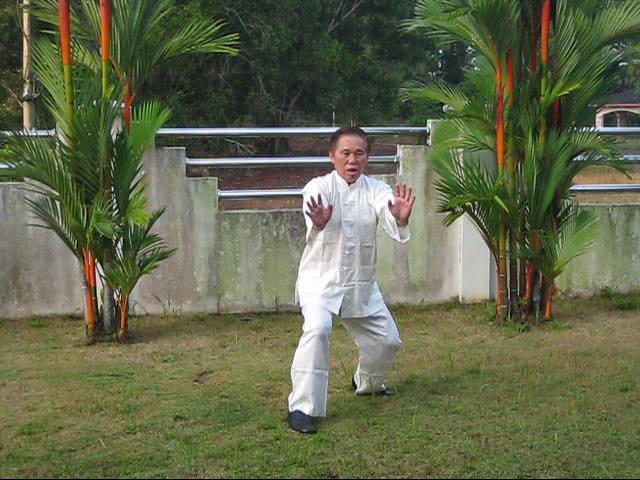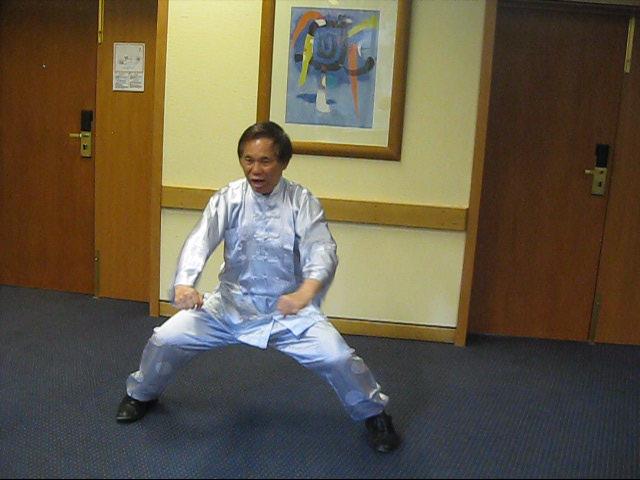INTERNAL FORCE IS NOT DYNAMIC TENSION

San Zhan of Wuzuquan
Question 7
There is a lot of misinformation in the world about internal force. For example, both the Sanchin of Karate and the San Zhan of Wuzuquan from which it was derived have both been described as "dynamic tension" exercises by sources claiming to be authoritative.
Iron Wire has been described as "qigong" meaning "meditative breathing" combined with isometric exercise/dynamic tension. "The Iron Wire form is essentially a combination of Hei Gung (Chinese: 气功; pinyin: qigong) or meditative breathing with isometric exercise, particularly dynamic tension, although weights were also used in traditional practice in the form of iron rings worn on the wrists. If properly practiced, it can increase strength considerably and promote a stable root. However as with both most forms of qigong and most forms of isometric exercise, it must be practiced regularly or the benefits are quickly lost."
Please can you define the difference between dynamic tension and internal force?
Please can you describe the difference in benefits a practitioner will gain from attending this course, “Secrets of Building Internal Force” versus a course on dynamic tension?
Sifu Andy Cusick
Answer
It is indeed sad, and shocking, that much misinformation about internal force and other aspects of internal arts is regarded by the ignorant public as authoritative given by people wrongly regarded as “masters”.
Sometimes the misinformation is ridiculous, and even hilarious. In my early years of teaching chi kung in Germany, a student told me that a famous chi kung “master” told him that he should not look at things, including pretty girls, for doing so would cause energy escaping from his eyes! “If you can’t even look at pretty girls, why do you practice chi kung then?” I asked him.
When I was in Canada, some students told me that their teacher, who was a world known chi kung “master”, forbid them to take sugar. This teacher would be shocked to know that I put three sachets of sugar into my coffee.
Indeed, when I first taught in Spain, many students were shocked to see the quantity of sugar I put into my drinks. Later when they found that I was still alive and kicking despite the sugar, they fed me with delicious ham.
Performing Sanchin of Karate or San Zhan of Wuzuquan as dynamic tension exercise is not only shocking, though it is often done, but is also dangerous. A student, who practiced Karate before, told me that his former Karate teacher advised him not to practice Sanchin often as it shortened his life. I wonder why the Karate teacher taught Sanchin in the first place.
Describing qigong as meditative breathing is incorrect. While meditative breathing may be used in some forms of chi kung, there are many forms of chi kung where practitioners are not concerned about their breathing, meditative or otherwise. Practicing Iron Wire with isometric exercise or dynamic tension is dangerous, especially when the harm is insidious. But many “masters” actually do that, developing big muscles instead of internal force.
It is true that if it is properly practiced, whether as genuine internal art or as isometric exercise, it can increase strength considerably and promote a stable root, the strength and root will be greater when practiced as an internal art besides more important benefits like good health, vitality and longevity. But it is not true when Iron Wire is correctly practiced as an internal art that its benefits are quickly lost. This is only true when it is wrongly practiced as isometric exercise.
In dynamic tension, muscles are tensed to produce strength. If the muscles are not tensed, strength is not produced. The amount of strength produced is related to the size of the muscles as well as the speed of muscular movement. The bigger the muscles, and the faster the speed, the more strength is produced.
Dynamic tension restricts energy flow, causing blockage which is detrimental to health. Dynamic tension is also stressful to the mind, or spirit. It “locks” the spirit, making the practitioner constraint, irritable or angry.
In internal force training, it is very important to be relaxed. Muscular tension blocks energy flow, which will stop the flow of internal force. The more relaxed a practitioner is, the greater will be the internal force generated. This is quite incomprehensive to many people, as they are used to the concept of muscular strength which requires tensing muscles, and ignorant of the concept of internal force. When a person is relaxed, together with internal force, he will produce better result no matter what he does.
Internal force training not only sets the spirit free, but also strengthens it. Hence, the practitioner feels liberated, peaceful and happy. Internal force training contributes to good health, vitality and longevity, whereas dynamic tension is detrimental.
As the name of the course reveals, course participants will learn the secrets of building internal force. On the other hand, in a course on dynamic tension, course participants will learn dynamic tension.
But why would anyone take a course on dynamic tension when a course on internal force, which is far superior, is available? Nevertheless, comparison with dynamic tension will be made when discussing the benefits participants get from the internal force course.
It is worth the effort and time to learn the secrets of building internal force because internal force is very beneficial. It is unnecessary to learn the secrets of dynamic tension because it is detrimental to health, vitality and longevity. Even the benefits dynamic tension can give, like strength and endurance, are inferior to the relevant benefits from internal force.
In the internal force course participants learn the two main methods of building internal force, i.e. the flow method and the force method. When they have acquired the two skills, they can apply them to almost any techniques.
For example, in Iron Wire, the standard way is to consolidate force using the force method, but course participants may even use the flow method. In Yang Style Taijiquan, the standard way is to increase energy flow using the flow method, but course participants may use the force method. This, I believe, is unprecedented in the whole history of chi kung and kungfu.
I do not know much about dynamic tension, but I believe there is only one method, which is tensing the muscles and relaxing them. I am doubtful that when one has acquired the skill of dynamic tension, he may apply the skill to other methods, if any. I believe many practitioners of dynamic tension may not even differentiate between skills and techniques and benefits.
There are countless benefits in internal force, but all these benefits may be classified into three categories:
- To maintain life.
- To enhance life.
- To have better result in whatever we do.
When disease-causing agents, like virus and negative emotions, get into our body, we remove them with our internal force, usually without our conscious awareness. This is an example of maintaining life.
When previously you became mentally tired easily and panting for breaths after some physical activities, now you can enjoy your work and play for a long time without becoming tired or panting for breaths. This is an example of enhancing life.
Previously you had to read over a page a few times and yet did not know what the author was writing. Now you read over the page once and comprehend clearly. This is an example of enabling you to have better result no matter what you do.
Apart from professions where big muscles count, like being a bouncer or a porter, and appearing muscular to other people, there are not many benefits of training in dynamic tension besides strength and endurance, which are still inferior to strength and endurance derived from internal force.
Training dynamic tension does not maintain life. In fact, it distracts from life. Energy that is meant to nourish internal organs is diverted to build big muscles.
Training dynamic tension does not enhance life. In fact, it distract from life. The internal organs and systems of dynamic tension builders have to work harder to compensate for the additional big muscles.
Training dynamic tension does not enable practitioners to have better result in what they do. In fact, they would do worse. After a dynamic tension session, practitioners have less mental clarity, due to the mental stress of the training, and less energy, due to energy being used up in the training. They would have to rest for some time to recover before they can perform their normal mental and physical work.
Hence, the difference in benefits participants get from an internal force course and from a dynamic tension course is great. It is not often that people have an opportunity to attend a course on “Secrets of Building Internal Force”. Needless to say, course participants do not just learn the secrets, they reap the benefits of internal force even during the course itself.

Iron Wire of Hoong Ka Kungfu
The questions and answers are reproduced from the thread Secrets of Building Internal Force in the Shaolin Wahnam Discussion Forum.
LINKS
